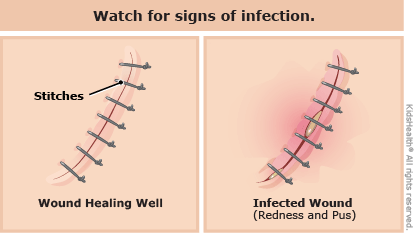When Does a Cut Need Stitches?
Most kids get bruises, scrapes, and cuts from time to time. Many small cuts can be treated at home by washing the wound and using a bandage. But it’s important to know when a cut might need medical care or even a few stitches.
Your child may need stitches if a cut:
- is still bleeding after you apply pressure for 5 minutes
- is gaping or wide
- looks deep
- is on your child’s face, lips, or neck
- has glass or other debris in it
- has an object sticking out of it, such as a twig
- spurts blood
If a cut is spurting blood, an artery might have been nicked. It’s important to put pressure on the wound with a clean cloth right away. The wound should be checked at an urgent care clinic or ER as soon as possible.
These guidelines can help you decide if a cut needs stitches. But doctors in your local clinic or emergency room are the ones will know for sure.
If Your Child Gets Stitches
A healing cut can get infected, so doctors clean them carefully. At home, help prevent infection by taking good care of the cut as it heals.

Check the wound every day. Some mild redness around it is normal. But call the doctor right away if:
- There’s growing redness, warmth, or swelling around the wound. This could be the start of an infection.
- Red streaks are coming from the wound.
- Pus drains from the wound.
- The edges of the wound start to separate.
- Your child develops pain or a fever.
- The stitches have started to come out or the wound is opening up.
A health care provider will take out the stitches later. How long they stay in depends on the kind of cut and where it is on the body. Sometimes, doctors put small white sticky tapes (called butterfly bandages or steri-strips) over the stitches to give them extra strength. These tapes loosen in a few days and fall off on their own.
Most cuts, even those fixed by stitches, leave a small scar. That’s because when the deeper layer of the skin is injured, the body uses the protein collagen to help fill in the cut area. The filled-in area becomes a scar. Over time, most scars fade or get smaller.
